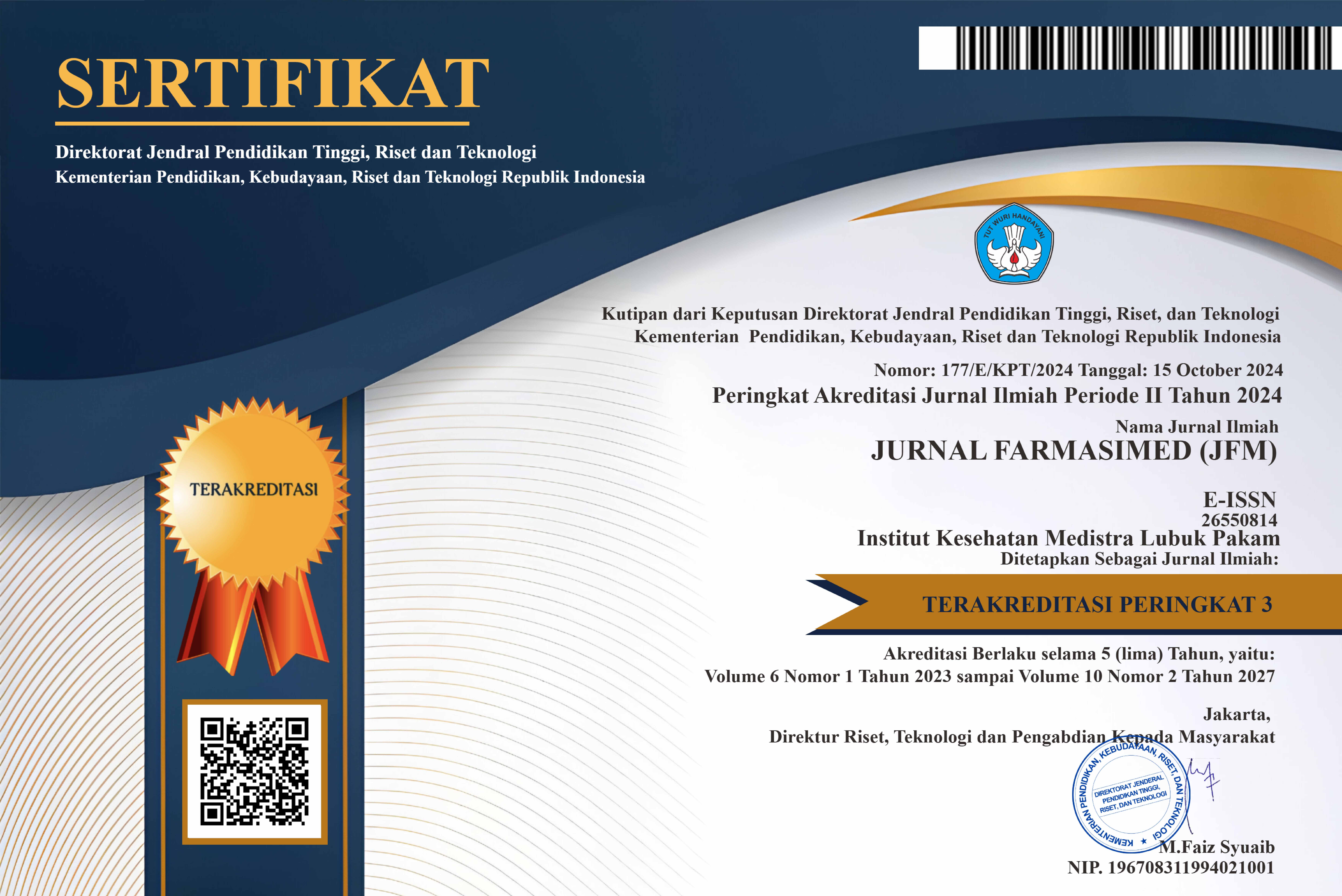Lotion Formulation with Papaya Seed Extract (Carica Papaya L) as a Skin Moisturizer
DOI:
https://doi.org/10.35451/jfm.v7i1.2342Keywords:
Formulation, Moisture, lotion, Papaya SeedsAbstract
Papaya seeds (Carica papaya L) have many vitamin contents that function to help increase immunity, fight free radicals, and also help increase skin moisture. Lotion is one of the pharmaceutical preparations in the form of beauty products that function to brighten and help increase skin moisture. In this research, a formulation of papaya seed extract will be made to become a lotion preparation that can increase skin moisture. This study tested the effectiveness of the preparation on the skin of volunteers. This study was conducted by making papaya seed extract through a maceration process using 96% ethanol, the extract was formulated in a lotion preparation in various concentrations. The resulting lotion was tested for homogeneity, pH, organoleptic, moisture and irritation on volunteers. Treatment was carried out for three days using lotion once a day. Lotion with a concentration of 3%, 5% and 7% which was homogeneous with a blank pH of 5.64, a 3% formulation pH of 5.84, a 5% formulation pH of 5.72, and a 7% formulation pH of 5.95 was found to not irritate the skin of volunteers, stable in room temperature storage. The results of the humidity test on Blanko were 43.3%, 3% formulation 45.2%, 5% formulation 49.95, 7% formulation 52.45%, and comparator 41%. The best result of the humidity test was formulation 3 with a concentration of 7% with an average value of 52.45%. Papaya seed extract can be formulated as a lotion preparation because it meets the physical test requirements of the preparation which shows that the preparation is homogeneous, the pH is stable during storage at room temperature, and does not irritate the skin. The papaya seed extract lotion preparation with a concentration of 7% provides a better humidity level effect compared to Blanko, F1 (3%), F2 (5%), F3 (7%) and also the comparator preparation.
Downloads
References
Andriyani, R., & Triana, A. (2015). Anatomi dan Fisiologi Kulit. 134–145. Ii, B. A. B. (2011). Centella asiatica Urb ).
Graha, W. P. S. (2018) “Hubungan Antara Peronal Hygienen Kulit Wajah dengan Tingkat Terjadinya Acne Vulgaris di Pondok Pesantren Al-Munawwar Yogyakarta.”
Lestari, R. (2022). Hubungan Sanitasi Lingkungan Dengan Gejala Penyakit Kulit Di Wilayah Kerja Puskesmas Sukamenanti Kabupaten Pasaman Barat. Nan Tongga Health And Nursing, 17(1), 14–23.
Daniati, E., & Nugroho Skom, A. (2017). Aplikasi Perawatan Wajah Berdasarkan Jenis Kulit Wajah.
Sifatullah, N., & Zulkarnain. (2021). Jerawat (Acne vulgaris): Review Penyakit Infeksi Pada Kulit. Prosiding Biologi Achieving the Sustainable Development Goals , November, 19–23.
Sudewi, S., Lubis, S. H., & Br. Perangin-angin, E. K. (2023). Formulasi Sediaan Lotion Ekstrak Etanol Buah Buncis (Phaseolus vulgaris L.) sebagai Pelembab Kulit. Jurnal Pharmascience, 10(1), 132. https://doi.org/10.20527/jps.v10i1.14441.
Dewi, S. R., N. Ulya dan B. D. Argo. 2018. “Kandungan Flavonoid dan Aktivitas Antioksidan Ekstrak Pleurotus ostratus. Roma Teknik Pertanian. Vol 11(1) : 1-11.
Airun, N. H. (2020). Pemanfaatan Biji Pepaya (Carica papaya L.) sebagai Biokoagulan pada Pengolahan Limbah Cair Industri Batik [Universitas Islam Indonesia]. https://dspace.uii.ac.id/handle/123456789/30456
Asmoro Bangun, P. P. (2021). Analisis kadar total flavonoid pada daun dan biji pepaya (carica papaya l.) Menggunakan metode spektrofotometer Uv-Vis. Jurnal Ilmiah Farmasi Attamru, 2(1), 1–5.
Abriyani, E., Amirulloh, N., Ulfiani, L., Fathurrohmah, A., Rismawati, A., Farmasi, F., Buana Perjuangan Karawang, U., Barat, J., & Abstract, I. (2023). Literatur Riview Jurnal Uji Antioksidan Tanaman Jamblang (Syzygium Cumini L.) Menggunakan Metode Dpph Dengan Spektrofotometer Uv-Vis. Jurnal Ilmiah Wahana Pendidikan, 2023(5), 8–19.
Damayanti, R. H., Meylina, L., & Rusli, d. R. (2017). Formulasi Sediaan Lotion Tabir Surya Ekstrak Daun Cempedak (Artocarpus champeden Spreng). 167-172.
Iskandar, B., Sidabutar, S. E. B., & Leny, L. (2021). Formulasi dan Evaluasi Lotion Ekstrak Alpukat (Persea Americana) sebagai Pelembab Kulit. Journal of Islamic Pharmacy, 6(1), 14–21.
Nurmala, T., Handayani, R. P., & Jamani, F. (2019). Pembuatan Sediaan Lulur Serbuk Tradisional Biji Pepaya (Carica papaya l) dan Pati Kedelai (Glycine max L) Untuk Mengatasi Kulit Kering. Pembuatan Sediaan Lulur Serbuk Tradisional Biji Pepaya (Carica Papaya L) Dan Pati Kedelai (Glycine Max L) Untuk Mengatasi Kulit Kering Tiya, 3(2), 89–94.
Amelinda, E., Widarta, I.W.R., Darmayanti, L.P.T., 2018. Pengaruh Waktu Maserasi Terhadap Aktivitas Antioksidan Ekstrak Rimpang Temulawak (Curcuma Xanthorriza Roxb.). J. Ilmu Dan Teknol. Pangan 7, 165.
Ariati, N. K., & Ratnayani, K. (2017). Skrining Potensi Jenis Biji PolongPolongan (Famili fabaceae) dan Biji Labu-Labuan (Famili Cucurbitaceae) sebagai Koagulan Alami Pengganti Tawas. Jurnal Kimia, 11(1), 15–22. https://doi.org/10.24843/jchem.2017.v11.i01.p03.
Mardikasari, S. A., Mallarangeng, A. N., & Zubaydah, W. O. (2017). Formulasi dan Uji Stabilitas Lotion dari Ekstrak Daun Jambu Biji (Psidium guajava L) Sebagai Antioksidan. Jurnal Farmasi, Sains dan Kesehatan, 3.
Annisa, Lulu. 2017. Formulasi dan Uji Stabilitas Fisika-Kimia Sediaan Gel Etil PMetoksisinamat Dari Rimpang Kencur (Kaempferia galanga Linn.). [Skripsi]. Jakarta. Fakultas Kedokteran dan Ilmu Kesehatan Program Studi Farmasi
Wiguna, Ayu Pradipta. 2016. Formulasi Sediaan Krim Minyak Atsiri Kayu Manis (Cinnamomum burmannii) Dengan Basis Vanishing Cream dan Uji Aktivitas Antibakterinya Terhadap Staphylococcus epidermidis. Fakultas Farmasi Universitas Muhammadiyah Surakarta.
Sari, Amelia., Maulidya, Amy. 2016. Formulasi Sediaan Salep Ekstrak Etanol Rimpang Kunyit (Curcuma longa Linn). Poltekkes Kemenkes Aceh, Lampeneurut, Aceh Besar. SEL Vol. 3 No. 1 Juli 2016: 16-23.
Rakhim, Mutia. 2016. Formulasi Sediaan Salep Minyak Atsiri Kemangi (Ocimum basilicum L.) dan Uji Aktivitas Antibakteri Terhadap Staphylococcus aureus. Fakultas Farmasi Universitas Muhammadiyah Surakarta.
Downloads
Published
Issue
Section
License
Copyright (c) 2024 Aminah Syarifuddin, Iga Juliana

This work is licensed under a Creative Commons Attribution-NoDerivatives 4.0 International License.
Copyright in each article is the property of the Author.

























